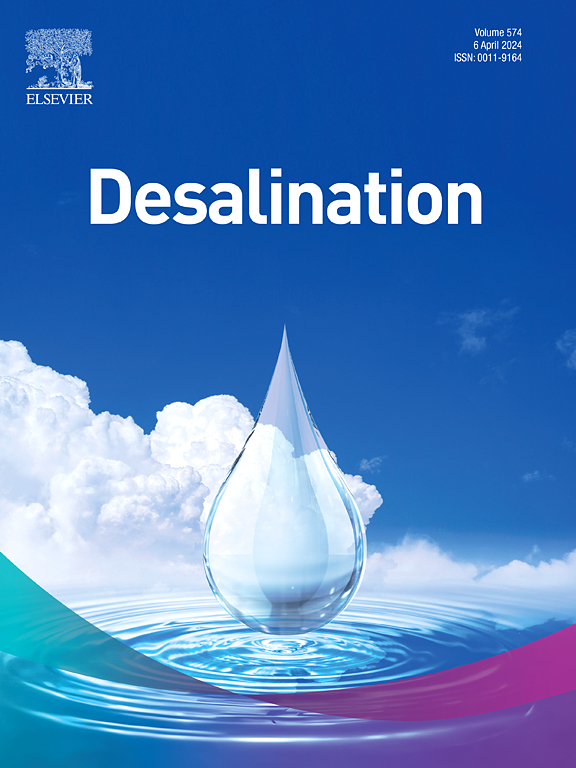Novel nanofiltration-reverse osmosis-high pressure nanofiltration membrane brine concentration (NF-RO-HPNF MBC) system for producing high purity high concentration sodium chloride brine from seawater
IF 8.3
1区 工程技术
Q1 ENGINEERING, CHEMICAL
引用次数: 0
Abstract
A pilot-scale study of a nanofiltration (NF) - reverse osmosis (RO) - membrane brine concentration (MBC) system was carried out using novel NF membranes for the NF and MBC systems. Two commercially available NF membranes with high magnesium rejection ability were tested for the removal of divalent ions from seawater. These membranes exhibited 81–87 % rejection of Ca and 95–97 % rejection of Mg at an 85 % recovery rate, resulting in a 4.3–5.3 times higher concentration of Ca and 5.4–6.7 times higher concentration of Mg in the NF reject than in the feed. Accordingly, the NF permeate had a high NaCl/TDS index of 96.7–97.8 %, facilitating the downstream production of high-purity NaCl salt. The potential of using NF membranes for brine concentration was investigated, and it was found that if a NF membrane could be operated at 75 bar, the NaCl solution could be concentrated to over 230 g/L. A pilot-scale trial was carried out on a 3-stage high pressure NF (HPNF) system, which achieved a concentration of 220 g/L from 78 g/L SWRO brine and 80 days of continuous operation. At a higher operating pressure, the system successfully concentrated the brine to 251 g/L as designed. The specific power consumption of the industrial 3-stage HPNF MBC system was estimated to be 111.0–123.3 kWh/t NaCl while concentrating from 75 g/L to 225 g/L and producing diluted steam at 43 g/L. This demonstrates competitiveness with conventional concentration methods such as thermal evaporation and electrodialysis.

新型纳滤-反渗透-高压纳滤膜浓盐水(NF-RO-HPNF MBC)系统从海水中制取高纯高浓度氯化钠盐水
采用新型纳滤膜对纳滤(NF) -反渗透(RO) -膜盐水浓缩(MBC)系统进行了中试研究。对两种市售的具有高除镁能力的纳滤膜进行了去除海水中二价离子的试验。这些膜对Ca的去除率为81 - 87%,对Mg的去除率为95 - 97%,回收率为85%,导致滤膜中Ca的浓度比饲料高4.3-5.3倍,Mg的浓度比饲料高5.4-6.7倍。因此,纳滤膜的NaCl/TDS指数高达96.7 ~ 97.8%,有利于下游生产高纯度NaCl盐。研究了利用纳滤膜进行卤水浓缩的潜力,发现如果纳滤膜在75 bar下工作,NaCl溶液可以浓缩到230 g/L以上。在3级高压滤水系统上进行了中试试验,78 g/L SWRO盐水的浓度达到220 g/L,连续运行80天。在更高的操作压力下,该系统成功地将盐水浓缩到251 g/L。工业三级hhpnf MBC系统在75 g/L浓缩至225 g/L、43 g/L稀释蒸汽时的比功耗估计为111.0-123.3 kWh/t NaCl。这证明了与传统浓缩方法(如热蒸发和电渗析)的竞争力。
本文章由计算机程序翻译,如有差异,请以英文原文为准。
求助全文
约1分钟内获得全文
求助全文
来源期刊

Desalination
工程技术-工程:化工
CiteScore
14.60
自引率
20.20%
发文量
619
审稿时长
41 days
期刊介绍:
Desalination is a scholarly journal that focuses on the field of desalination materials, processes, and associated technologies. It encompasses a wide range of disciplines and aims to publish exceptional papers in this area.
The journal invites submissions that explicitly revolve around water desalting and its applications to various sources such as seawater, groundwater, and wastewater. It particularly encourages research on diverse desalination methods including thermal, membrane, sorption, and hybrid processes.
By providing a platform for innovative studies, Desalination aims to advance the understanding and development of desalination technologies, promoting sustainable solutions for water scarcity challenges.
 求助内容:
求助内容: 应助结果提醒方式:
应助结果提醒方式:


